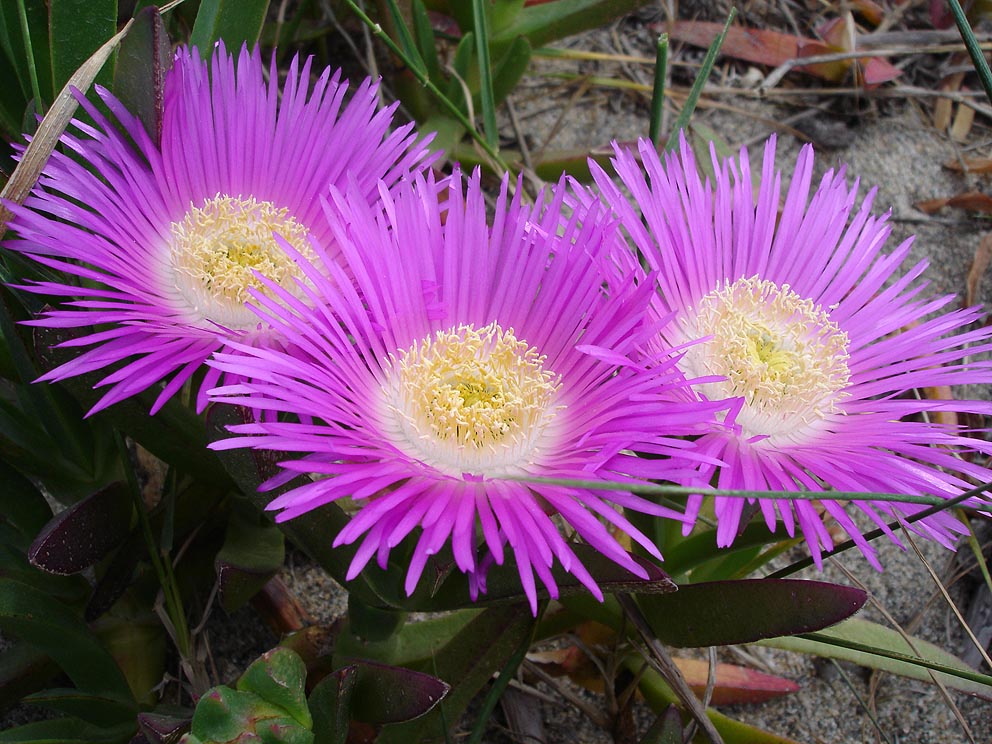- Carpobrotus
image_width = 240px
image_caption = "Carpobrotus edulis "
regnum =Plant ae
phylum =Magnoliophyta
classis =Magnoliopsida
ordo =Caryophyllales
familia =Aizoaceae
genus = "Carpobrotus"
subdivision_ranks =Species
subdivision = "C. acinaciformis" "C. aequilaterus" "C. chilensis" "C. edulis" "C. glaucescens" "C. modestus" "C. rossii" "C. virescens" and othersCarpobrotus is a
genus of ground-creeping plants, withsucculent leaves and large daisy-like flowers. The name refers to the edible fruits. It comes from the Greek "karpos" (fruit) and "brota" (edible).There are about 25 species in this genus, having a disperse distribution worldwide. They are mostly
South Africa n, but there is one species inSouth America , another inCalifornia andOregon [ [http://plants.usda.gov/java/profile?symbol=CACH38 USDA Plant Profile Carpobrotus] ] , and four inAustralia (NSW Flora Online). Common names includeice plant and pigface. On of the subdivisions of Carpobrotus, "C. glaucescens", is noted for having salty fruit, a rare property in fruits. [ [http://www.abc.net.au/science/articles/2008/06/11/2271070.htm?site=science/askanexpert&topic=enviro Is there a salty fresh fruit?] ]Ground Cover
Carpobrotus acinaciformis, also referred to in the United States as the Icicle Plant, Strand Ivy, Cape Fig Hottentots Fig, and Sour Fig, is often used for ground cover due to its fast growth, ground hugging characteristics, and resistance to fire [ [http://72.14.253.104/search?q=cache:qmf6k1Y4jjwJ:www.plantzafrica.com/medmonographs/carpobrotacina.pdf+carpobrotus+acinaciforme&hl=en&ct=clnk&cd=7&gl=us&client=firefox-a African Succulent Plants] ] . Carpobrotus is also drought resistant.
Medicinal Properties
Carpobrotus juice (from leaves) can be used as a mild astringent. When mixed with water the juice can be used to treat diarrhea, dysentery and stomach cramps. It can also be used as a gargle for sore throat and laryngitis, and mild
bacterial infections of the mouth [ [http://www.plantzafrica.com/plantcd/carpobed.htm Uses & Cultural Aspects] ] The leaf juice can also be used externally, much likeAloe Vera for burns, abrasions, open cuts, grazes, mosquito bites and sunburn. It is also used to treat ringworm, eczema, dermatitis, herpes, thrush, cold sores, cracked lips, chafing, skin conditions and allergies.An ancient remedy for
constipation is to eat the fruit withbrackish water. Syrup made from the fruit is said to havelaxative properties. A mixture of leaf juice, honey and olive oil in water is an old remedy for TB.Gallery
References
External links
* [http://plantnet.rbgsyd.nsw.gov.au/cgi-bin/NSWfl.pl?page=nswfl&lvl=gn&name=Carpobrotus NSW Flora online - Carpobrotus]
Wikimedia Foundation. 2010.

